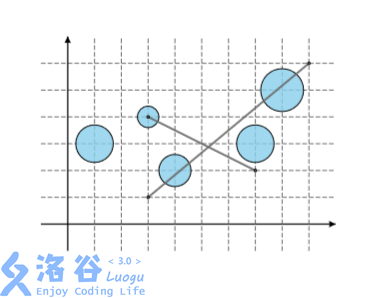#P4354. [CERC2015] Ice Igloos
[CERC2015] Ice Igloos
题目描述
A fishing village built on the surface of a frozen lake far north in the arctic is endangered by global warming-fractures are starting to form on the lake surface. The village consists of n igloos of spherical shape, each occupying a circular area of the surface.
An igloo can be represented as a circle in the coordinate plane: the center of the circle is a point with integer coordinates, while the radius is a positive floating-point number less than 1 with exactly one fractional digit.
Given the locations of possible ice fractures, the villagers would like to know how many igloos are affected by each. Formally, given q queries where each query is a straight line segment defined by the two endpoints, find the number of igloos each segment intersects. A segment intersects an igloo if it has at least one point in common with the interior of the circle.
输入格式
The first line contains an integer n (1≤n≤100000) - the number of igloos. Each of the following n lines contains three numbers x, y and r – the coordinates of the center and the radius of one igloo. The coordinates x and y are integers such that 1≤ x, y≤500, while r is a floating-point number with exactly one fractional digit such that 0 < r < 1. No two igloos will intersect or touch.
The following line contains an integer q (1 ≤ q ≤ 100000) - the number of queries. Each of the following q linescontainsfourintegers x1, y1, x2, y2 (1≤ x1, y1, x2, y2 ≤500)-thecoordinatesofthe two endpoints of the segment. The two endpoints will be different. Endpoints may be inside igloos.
You may assume that, for every igloo i and the segment s, the square of the distance between s and the center of i is either less than r2−10−5 or greater than r2 +10−5 where r is the radius of the igloo i.
输出格式
Output should consist of q lines. The k-th line should contain a single integer – the number of igloos that are intersected by the k-th segment.
5
4 2 0.6
7 3 0.7
8 5 0.8
1 3 0.7
3 4 0.4
2
3 1 9 6
3 4 7 2
2
1
提示

Central Europe Regional Contest 2015 Problem I
